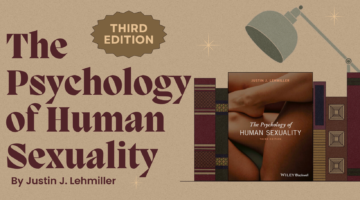Ten Things Science Taught Us About Sex In 2020
December 30, 2020 by Justin Lehmiller
2020 has been memorable for a lot of reasons—including what science taught us about sex. Here’s a quick recap of some of the most interesting things we learned about sex this year.
1.) Spending time naked with strangers can improve body image.
This year brought us the first-ever randomized controlled trial of communal nudity, in which half of the participants were given an opportunity to socialize in the buff—in a safe space—while the other half did so fully clothed. For participants in the naked condition only, body image was significantly more positive at the end of the study than it was in the beginning. This change occurred, in part, because nudity reduced “social physique anxiety” (anxious feelings about the way others look at your body). These findings suggest that for those who are open to trying it, spending more time naked just might offer some psychological benefits. Learn more about this study here.
2.) Men who pay for sex actually have more positive attitudes toward gender equality.
Many people believe that men who buy sex do not value women or gender equality. However, research suggests otherwise. In an online survey of more than 500 men who had paid for sex, researchers compared their views on gender equality to those of men in the general population. What they found was that attitudes relating to women’s roles in the workplace, home, and politics tended to be more positive among men who had paid for sex compared to the national average. This suggests that men who pay for sex do not necessarily devalue women more than other men; in fact, it anything, the reverse appears to be true. Learn more about this research here.
3.) How women feel about their romantic partners depends, in part, on where they are in their menstrual cycle.
In a longitudinal study in which researchers tracked women’s menstrual cycles and collected daily reports on how they felt about their intimate lives, they found that women’s evaluations of their partners turned negative during ovulation, but rebounded afterwards. What’s behind these shifts? The researchers argue that because the negative changes in partner evaluation occurred during peak fertility, this may be a sign that women evolved to subtly distance themselves from their partners at that time in order to capitalize on other mating opportunities that might come along. Read more about this study here.
4.) Some pick-up lines work better than others, but their success depends on the appearance of the person delivering them.
Which pick-up lines tend to land the best? In an online survey, heterosexual men were asked to evaluate the effectiveness of several different types of opening lines. Each line was accompanied by a photo of a woman reported to have used the line. It turned out that direct lines (where people openly communicate their interest and/or offer a compliment, such as “You have really nice eyes”) were most preferred, followed by flippant lines (such as “I’m easy, are you?”), then innocuous lines (such as “Hi.”). However, direct lines were considered most effective when delivered by a woman who was highly attractive. These lines were less effective for women of lower attractiveness, but were more effective when she was dressed in a way that revealed more of her body. Learn more about this research and the psychology of pick-up lines here.
5.) Republicans had more sex during the pandemic than did Democrats.
In general, people reported more declines that improvements in their sex lives during the pandemic. However, some people were more likely to experience declines than others—and it turns out that it depended, in part, on people’s political affiliations. In our Kinsey Institute study on how COVID-19 is changing our intimate lives, we found that people who identified as more conservative were actually more sexually active during the lockdown/quarantine period than those who self-identified as liberal. There are several possible reasons for this. One has to do with social distancing adherence—liberals were more likely to report sticking to social distancing guidelines than were conservatives. Also, liberals (compared to conservatives) reported feeling more stressed and lonely, and they reported more concern for their health. Learn more about this research here—and watch this video for a broader look at how the pandemic affected people’s sex lives.
6.) 1 in 3 young men have not had sex in the last year—but it’s not because they’re watching porn instead.
A nationally representative US study found that the number of 18-24-year-old men reporting no partnered sex during the past year increased from 18.9% in the early 2000s to 30.1% almost two decades later. Put another way, 1 in 3 young men today are reporting not having had sex for at least a year. What’s behind this shift in sexual behavior? It doesn’t appear to be due to changes in porn use. In fact, in this study, porn users tended to be more—not less—sexually active. However, the researchers did find that men who made less money and/or who were unemployed or underemployed were more likely to report sexual inactivity. Read more about other possible reasons and additional findings from this study here.
7.) Some people intentionally try to hurt themselves through sex to regulate negative emotions—not because they find pain to be sexually arousing.
Some people use sex as a means of self-injury—for them, sex is a purposefully sought way of harming the self physically or psychologically. For example, this might involve intentionally seeking out sex with an abusive person or having sex with someone considered disgusting as a form of punishment or humiliation. In a study of people who had previously engaged in sex as self-injury, one of the primary motivations described was emotional regulation, including seeking relief from depression, anxiety, and/or contempt for the self. This behavior is distinct from sexual masochism and should not be lumped into the same category as BDSM, given that sexual pleasure is not the overriding goal or motive and typical kinky sex precautions are not being taken (i.e., ensuring that everything is “safe, sane, and consensual”). Learn more about the psychology behind sex as self-injury here.
8.) There are at least 4 types of multiorgasmic women.
A study of more than 400 multiorgasmic women found that women’s experiences with multiple orgasms are very diverse. Researchers found that there were at least four “types” of multiorgasmic women who varied in terms of their sexual motivation (e.g., how interested they are in sex and how sexually adventurous they are), their previous sexual history (e.g., their degree of sexual self-exploration), and the nature of their multiple orgasms (e.g., how many orgasms they typically have). This study also revealed that there isn’t just one “recipe” for multiple orgasms and that multiorgasmic episodes can look very different, ranging from 2 to over 100 orgasms in a single sexual session. Learn more about multiple orgasms in women here.
9.) Your personality may predict your likelihood of being cheated on in a relationship.
In a nationally representative US study of nearly 1,600 adults, researchers looked at how the Big Five personality traits were linked to whether people had ever been cheated on by their partners. They found that the more conscientious people were (i.e., being detail-oriented, hardworking, organized, and responsible), the less likely they were to have been cheated on. Why is that? It may be because detail-oriented people tend to put more work/effort into their relationships and that this reduces the odds of cheating occurring. By contrast, the more agreeable people were (i.e., having more care and concern for the well-being of others), the more likely they were to have been cheated on. Why are “nicer” people more likely to have been cheated on? Perhaps people with agreeable partners tend to take them for granted, or assume that they can get away with bad behavior because they believe their partner will forgive them. Learn more about this study here.
10.) Straight women and gay men seem to feel very differently about receiving unsolicited dick pics.
In study of more than 2,000 adults who were diverse in gender and sexual orientation, researchers found that receiving unsolicited dick pics is a common experience—however, people’s reactions to these photos vary considerably. Specifically, heterosexual women were far more likely to perceive these photos as a form of sexual harassment and to feel disgusted or violated compared to gay and bisexual men, who were far more likely to say they felt aroused, entertained, or flattered. This isn’t to say that everyone had the same reactions, though—for example, some straight women reported positive reactions and some gay and bi men reported negative reactions. In other words, individual reactions vary, but there are sizeable average group differences based on gender and sexual orientation. Learn more about this research here, as well as some tips on how to obtain consent prior to sending nude photos online. Get consent first because it’s the right thing to do—and it increases the odds of a favorable reaction.
Want to learn more about Sex and Psychology ? Click here for previous articles or follow the blog on Facebook (facebook.com/psychologyofsex), Twitter (@JustinLehmiller), or Reddit (reddit.com/r/psychologyofsex) to receive updates. You can also follow Dr. Lehmiller on YouTube and Instagram.
Image Source: 123RF

Dr. Justin Lehmiller
Founder & Owner of Sex and PsychologyDr. Justin Lehmiller is a social psychologist and Research Fellow at The Kinsey Institute. He runs the Sex and Psychology blog and podcast and is author of the popular book Tell Me What You Want. Dr. Lehmiller is an award-winning educator, and a prolific researcher who has published more than 50 academic works.
Read full bio >


